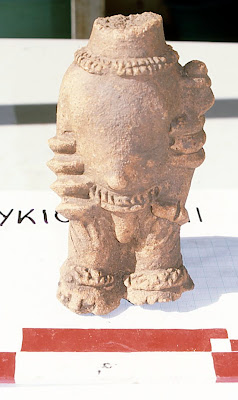 by Kathryn Hadley
by Kathryn HadleyManchester University announced yesterday, February 16th, the discovery of 80 ancient clay figures in Ghana by archaeologists from the universities of Manchester and Ghana. The sculpted human and animal figures, which are believed to be between 1,400 and 800 years old, were unearthed last month from a series of mounds in a remote region of Northern Ghana near the village of Yikpabongo. The 30km square area is so densely packed with a series of mysterious mounds that it took just two weeks to excavate the 80 figures.
Human skulls were also discovered in the mounds. Dr Benjamin Kankpeyeng from Ghana and Tim Insoll from Manchester University believe that they may be the sites of ancient shrines. It is hoped that studies of the number, context and arrangement of the figurines will provide an insight into the ritual practices and beliefs of this ancient society and deepen our understanding of what remains a relatively unknown and little-researched page of African history.
In the words of Professor Tim Insoll:
‘These finds will help to fill a significant gap in our scant knowledge of this
period before the Islamic empires developed in West Africa. They were a
sophisticated and technically advanced society: for example some of the
figurines were built in sections and slotted together.’
Dr Benjamin Kankpeyeng further explained:
‘The relative position of the figurines surrounded by human skulls means the
mounds were the location of an ancient shrine. The skulls had their jaw bones
removed with teeth placed nearby - an act of religious significance.’
However, illegal excavation of the treasures means that archaeol
 ogists are in a race against time to ensure the safety of the remains.
ogists are in a race against time to ensure the safety of the remains.Residues of material were also discovered packed into holes within the figurines. What exactly was put into the holes - medicinal substances, blood or other material from a sacrifice - is unknown, however. Some of the figures have been brought back to the UK where Professor Insoll is due to carry out further analysis of these residues in an effort to uncover more clues about the society.
The burial sites have been repeatedly excavated over the past 25 years. The first excavation took place in 1985 with others in 2007, 2008 and 2009 carried out by the University of Ghana. Nevertheless, many questions remain unanswered.
Insoll explained:
‘There are still many questions remaining: some of the figurines were
deliberately broken and placed besides body parts. Why?’
Kankpeyeng added:
‘What is interesting is that the people now living in this area seem to have no
connection with the makers of the figurines. That would suggest that that they
have more in common with peoples living in other parts of West Africa - but we
need to do more work before we can be certain.’

No comments:
Post a Comment